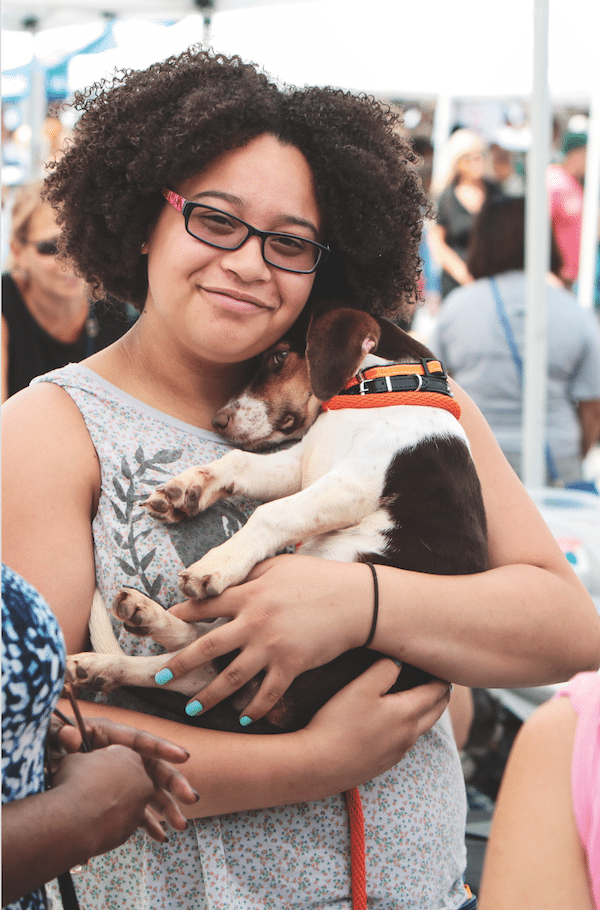Editor’s note: Have you seen the new Dogster and Lucky Puppy magazines in stores? Or in the waiting room of your vet’s office? This article appeared in our Fall issue. Subscribe to Dogster and get the magazines delivered to your home.
Whether you currently have zero pets or three, you can share the love by volunteering. There are more ways to volunteer than you might realize, even if you have a busy schedule. Volunteering is incredibly fulfilling for you and the animals who benefit from even just a little of your time.
“We love our volunteers and rely greatly on their dedication and commitment to helping animals in need,” said Gail Buchwald, senior vice president of the ASPCA Adoption Center in New York. “Without volunteers, the animals wouldn’t receive as much TLC, which is important for quality of life, reduces risk of getting sick, and prepares them to meet future adopters.”
Making time to give back
Between work and home life obligations, everyone is pressed for time. But adding small volunteering gigs to your regular routine doesn’t have to be a burden.
“I often get asked how I have any spare time to volunteer,” said Katie Sershon, a PR and communications manager for a global financial services firm. “I like to put it in perspective — if I do one three-hour shift once a week at PAWS Chicago, I miss out on watching an episode of Scandal, Billions, and The Bachelor. That’s it.” Sershon volunteers on-site walking and socializing dogs, as well as fostering dogs at home.
If you have a schedule that fluctuates, that’s OK. “Sometimes work takes priority and I can’t foster a dog, so I just commit to one shift,” Sershon said. “Some months my job eases up and I have no travel planned, so I take a foster dog that requires more obedience training and energy.”
Even volunteering infrequently makes a difference. “We have people who collect blankets for the dogs and bring them once or twice a year,” said Rhonda Surfas, director of Southern California Bull Terrier Rescue in Los Angeles County. “Things like this make a direct impact.”
Another way Southern California Bull Terrier Rescue benefits from infrequent volunteers is adoption events, such as the group’s booth at America’s Family Pet Expo in Orange County, California.
“The booth is manned by volunteers working four-hour shifts talking to the public about adopting Bull Terriers and showing off adoptable dogs,” Surfas said.
Creating a schedule that works for you helps avoid the dreaded B-word. “I avoid burnout by doing everything in moderation,” Seshon said. “After a really stressful day at work it’s great to unplug and be 100 percent focused on the dogs.”

Woman volunteering with animals by iStock.
Ways to help
If you’re able to spend time at a shelter or rescue, volunteer opportunities include dog walking, playing with dogs, and basic training, as well as cat socializing, and bottle-feeding kittens. “There are also opportunities for adoption counseling, which involves assisting potential adopters in selecting a pet who best fits their lifestyle,” Buckwald added.
Surfas’ primary need for volunteers is transporting dogs, which has become invaluable. “Many dogs’ lives have been saved because a volunteer has come forward to transport them for us,” she said. “It would be virtually impossible for me to pick up and transport all of them.”
You can also help from home. Tailor your efforts to your skill set. “Use your expertise to help the organization — marketing, HR, communications, finance, administrative — whatever you are good at,” Sershon suggested.
“Shelters can often use volunteer assistance with special projects, such as photographing the animals and writing blogs,” Buckwald added.
Possibly the ultimate way to volunteer is by fostering a dog. “It can be so rewarding and you would be saving a life,” Surfas said. “Rescues can only (house) so many, so any that we can get into foster homes is like having additional space.”
Sershon has fostered 16 dogs in two years for PAWS Chicago. “It’s amazing to see a creature that I loved and cared for finally getting its chance in a forever home,” she said.
Getting started
You might feel a little out of your element when you first start, but people are there to help. Buckwald said volunteers at the ASPCA Adoption Center receive classroom and hands-on training to ensure a safe volunteer experience.
Consider Sershon’s recommended approach: “First, commit your time to one organization that you really care about. Second, commit to volunteering at least once a week consistently for three months. By month three you’ll understand the ins-and-outs of the organization and feel comfortable with the staff, other volunteers, animals, and potential adopters.”
The ultimate beneficiaries of volunteering are the pets, but you will benefit, too. “I’ve gained more from volunteering than I give,” Sershon said. “It’s helped me develop a new skill set, make connections and friends, gain a new perspective, and grow as a person.”
The post How to Make Time in Your Life for Volunteering With Animals in Need appeared first on Dogster.
No comments:
Post a Comment